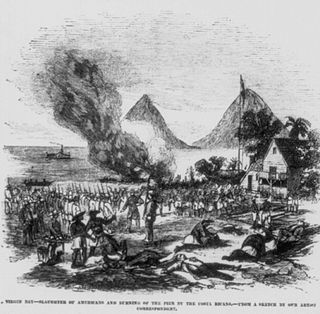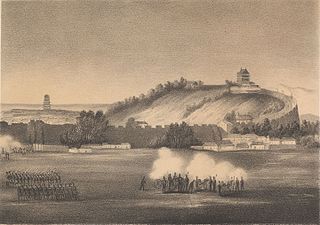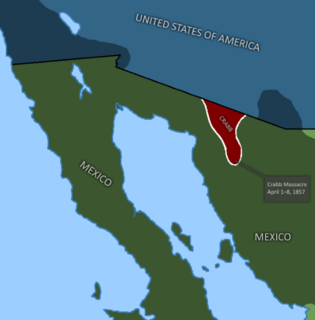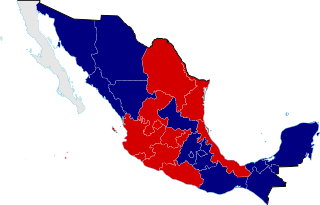 W
WThe Anglo–Persian War or Anglo-Iranian War lasted between November 1, 1856 and April 4, 1857 and was fought between the British Empire and Iran (Persia), then ruled by the Qajar dynasty. The war had the British oppose an attempt by Iran to press its claim on the city of Herat. Though Herat had been part of Iran under the Qajar dynasty when the war broke out, it had declared itself independent under its own rebellious emir and placed itself under the protection of the British in India and in alliance with the Emirate of Kabul, the predecessor of the modern state of Afghanistan. The British campaign was successfully conducted under the leadership of Major General Sir James Outram in two theatres: on the southern coast of Iran near Bushehr and in southern Mesopotamia.
 W
WThe Siege of Arrah took place during the Indian Mutiny. It was the eight-day defence of a fortified outbuilding, occupied by a combination of 18 civilians and 50 members of the Bengal Military Police Battalion, against 2,500–3,000 mutinying Bengal Native Infantry sepoys from three regiments and an estimated 8,000 men from irregular forces commanded by Kunwar Singh, the local zamindar or chieftain who controlled the Jagdishpur estate.
 W
WThe Filibuster War or Walker affair was a military conflict between filibustering multinational troops stationed in Nicaragua and a coalition of Central American armies. An American, William Walker, briefly invaded Nicaragua in 1855 with a small army. He seized control of the country by 1856, but was ousted the following year.
 W
WThe Battle of Canton was fought by British and French forces against Qing China on 28–31 December 1857 during the Second Opium War. The British High Commissioner, Lord Elgin, was keen to take the city of Canton (Guangzhou) as a demonstration of power and to capture Chinese official Ye Mingchen who had resisted British attempts to implement the 1842 Treaty of Nanking. Elgin ordered an Anglo-French force to take the town and an assault began on 28 December. Allied forces took control of the city walls on 29 December but delayed entry into the city itself until 5 January. They subsequently captured Ye and some reports state they burnt down much of the town. The ease with which the allies won the battle was one of the reasons for the signing of the Treaty of Tientsin in 1858.
 W
WThe Crabb massacre was the culmination of the eight-day Battle of Caborca. It was fought between Mexico and their O'odham allies against American forces in April 1857. Due to the outbreak of the Reform War in Mexico, the rebel Ygnacio Pesqueira invited the American politician Henry A. Crabb to colonize the northern frontier region in the state of Sonora, on the basis that the colonists would help Pesqueira fight in the civil war and against the Apache. However, when Crabb arrived in Mexico, his command was attacked and ultimately defeated. Some 50 survivors of the battle, out of about 85 men, were murdered by the Mexicans.
 W
WThe Battle of Devil's River was an 1857 Indian War skirmish which took place in Texas along the Devils River. A small force of United States Army cavalry defeated an overwhelming force of Comanche braves after an epic journey across the desert.
 W
WThe Ecuadorian–Peruvian War took place between 1857 and 1860. The conflict began when Ecuador attempted to sell Amazon basin land claimed by Peru in order to settle a debt with British creditors. When diplomatic relations between the two countries broke down, prior to the fragmentation of the Ecuadorian government into several competing factions, the Peruvian government ordered a blockade of Ecuador's ports in order to force the cancellation of the sale, and the official acknowledgement of Peruvian ownership of the disputed territories. By late 1859, control of Ecuador was consolidated between General Guillermo Franco, in the city of Guayaquil, and a provisional government in Quito headed by Gabriel García Moreno. Peruvian President Ramón Castilla sailed to Guayaquil with several thousand soldiers in October 1859, and negotiated the Treaty of Mapasingue with General Franco in January 1860. The signing of the treaty indicated Ecuadorian compliance with all of Peru's demands, and temporarily marked the end of the territorial dispute between the two countries. However, in September 1860, the forces of the provisional government, commanded by García Moreno and General Juan José Flores defeated Franco's government at the Battle of Guayaquil, ending the civil war in Ecuador. The new government disavowed the Treaty of Mapasingue, followed shortly afterwards by its Peruvian counterpart; this re-opened the territorial dispute.
 W
WThe Battle of Escape Creek was a naval engagement fought between the United Kingdom's Royal Navy and the Qing Chinese naval force on 25–27 May 1857 during the Second Opium War. Commodore Charles Elliot's squadron chased the war-junks at Escape Creek and then, once the British ships were grounded as the river narrowed, they chased them in the ships' boats until all the junks had been overhauled.
 W
WThe Indian Rebellion of 1857 was a major, but ultimately unsuccessful, uprising in India in 1857–58 against the rule of the British East India Company, which functioned as a sovereign power on behalf of the British Crown. The rebellion began on 10 May 1857 in the form of a mutiny of sepoys of the Company's army in the garrison town of Meerut, 40 mi (64 km) northeast of Delhi. It then erupted into other mutinies and civilian rebellions chiefly in the upper Gangetic plain and central India, though incidents of revolt also occurred farther north and east. The rebellion posed a considerable threat to British power in that region, and was contained only with the rebels' defeat in Gwalior on 20 June 1858. On 1 November 1858, the British granted amnesty to all rebels not involved in murder, though they did not declare the hostilities to have formally ended until 8 July 1859. Its name is contested, and it is variously described as the Sepoy Mutiny, the Indian Mutiny, the Great Rebellion, the Revolt of 1857, the Indian Insurrection, and the First War of Independence.
 W
WThe Battle of Khushab took place on 7 February 1857 and was the largest single engagement of the Anglo-Persian War. Having taken Borazjan without a fight, the British expeditionary army under Sir James Outram was in the process of withdrawing to Bushehr when it was ambushed by a far larger Persian force under Khanlar Mirza, drawn up in battle order to its rear. The battle ended with Persian victory and the withdrawal of British troops from Ahvaz, Iran.
 W
WThe Battle of Macao Fort was fought between British and Chinese forces in the Pearl River, Guangdong, China on 4 January 1857 during the Second Opium War. Macao Fort was located on an islet about 3 miles south of Canton (Guangzhou).
 W
WThe Pahang Civil War, also known as The Brothers War or the Bendahara War was a civil war fought from 1857 to 1863, between forces loyal to the reigning Raja Bendahara Tun Mutahir, and forces loyal to his brother Wan Ahmad, over the succession to the throne of Pahang.
 W
WThe War of Reform in Mexico, during the Second Federal Republic of Mexico, was the three-year civil war (1857–1860) between members of the Liberal Party who had taken power in 1855 under the Plan of Ayutla, and members of the Conservative Party resisting the legitimacy of the government and its radical restructuring of Mexican laws, known as La Reforma. The Liberals wanted to eliminate the political, economic, and cultural power of the Catholic church as well as reduce the role of the Mexican Army. Both the Catholic Church and the Army were protected by corporate or institutional privileges (fueros) established in the colonial era. Liberals sought to create a modern nation-state founded on liberal principles. The Conservatives wanted a centralist government, some even a monarchy, with the Church and military keeping their traditional roles and powers, and with landed and merchant elites maintaining their dominance over the majority mixed-race and indigenous populations of Mexico.
 W
WThe Siege of Fort Medina took place in 1857 at Médine on the left bank of the Senegal River, in modern-day Mali, when the Toucouleur forces of Omar Saidou Tall unsuccessfully besieged native and French colonial troops under General Louis Faidherbe, governor of Senegal.
 W
WThe Spirit Lake Massacre was an attack by a Wahpekute band of Santee Sioux on scattered Iowa frontier settlements during a severe winter. Suffering a shortage of food, the renegade chief Inkpaduta led 14 Sioux against the settlements near Okoboji and Spirit lakes in the northwestern territory of Iowa near the Minnesota border, in revenge of the murder of Inkpaduta's brother, Sidominadotah, and Sidominadotah's family by Henry Lott. The Sioux killed 35-40 settlers in their scattered holdings, took four young women captive, and headed north. The youngest captive, Abbie Gardner, was kept a few months before being ransomed in early summer. It was the last Native American attack on settlers in Iowa, but the events increased tensions between the Sioux and settlers in the Minnesota Territory. Nearly 30 years after the events, in 1885 Gardner-Sharp published her memoir, History of the Spirit Lake Massacre and Captivity of Miss Abbie Gardner, which was reprinted several times in small editions. It was one of the last captivity narratives written of European Americans' being held by Native Americans. In 1891, Gardner-Sharp purchased the primitive family cabin and returned home. For the last 30 years of her life, she subsisted on the modest earnings from her book and souvenir sales. The town erected an historical monument to commemorate the attack. The State of Iowa now maintains the park and Abbie Gardner Sharp home site.
 W
WThe Yakima War (1855-1858) was a conflict between the United States and the Yakama, a Sahaptian-speaking people of the Northwest Plateau, then part of Washington Territory, and the tribal allies of each. It primarily took place in the southern interior of present-day Washington. Isolated battles in western Washington and the northern Inland Empire were sometimes separately referred to as the Puget Sound War and the Palouse War, respectively. This conflict is also referred to as the Yakima Native American War of 1855.